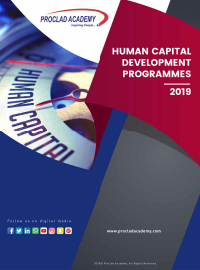Data Analysis Techniques & Practices
| Ref No. | Dates | Venue | Fee (US$) | |
|---|---|---|---|---|
| ME 001 | 05 - 09 Apr 2020 | Dubai | 4500 | Register |
| ME 001 | 19 - 23 Jul 2020 | Dubai | 4500 | Register |
| ME 001 | 04 - 08 Oct 2020 | Dubai | 4500 | Register |
| ME 001 | 27 - 31 Jan 2020 | Dubai | 4500 | Register |
Data Analysis Techniques & Practices
Introduction
Analysing data helps to make meaningful business decisions, improve efficiency and profits. Appropriate interpretation of numerical data will strengthen the ability to make significant impact in providing, using or evaluating data for improved business performance.
PROCLAD Academy’s Data Analysis Techniques & Practices training course introduces statistical techniques. It explains and builds upon the fundamentals of statistical analysis, including probability, the normal distribution and standard deviation. Graphical tools such as the histogram, scatter plot and regression charts are introduced. The course also describes important terminology and includes examples which illustrate the use of key tests such as the F and Z tests; defines the meaning of capability, variation and control charts, and examples illustrate why they are useful.
The key features of PROCLAD Academy’s Data Analysis Techniques & Practices training course are:
- Interpretation of large data sets
- Modeling and 'what-if' scenarios
- Establishing data integration
- Developing dynamic dashboards and scorecards
- Designing key performance indicators
Learning Objectives
Participants attending PROCLAD Academy’s Data Analysis Techniques & Practices training course will be able to:
- Understand some of the key terminology used in statistical analysis
- Understand the meaning of variable data, and the difference between common and special causes of variation
- Explain and give examples of the two causes of variation in processes
- Explain what is meant by process capability
- Understand the benefits of control charts, when they are used, and be able to construct them
- Summarise the five stages of DMAIC
- State the five ways of characterising a process measurement system
- State ways of ensuring a measurement system is reliable
Target Audience
PROCLAD Academy’s Data Analysis Techniques & Practices training course is aimed at, but not limited to:
- Engineers, technologists and professionals whose jobs involve the manipulation, representation, interpretation and analysis of data
- Professionals who needs to use data analysis in their job role, including strategists, business analysts, etc.
- Professionals who wish to gain knowledge of Data Analysis in order to improve their analytical skills and understanding of data
- Personnel moving into roles where they will need to produce data and/or use data to make decisions
Training Methodology
PROCLAD Academy’s practical and results-oriented Data Analysis Techniques & Practices training course is based on adult learning concepts. It incorporates short inspiring lectures with structured lessons from the learning manual; captivating PowerPoint slides with videos to enhance learning; ongoing discussions with action planning; ample time for Q&A; training activities to reinforce key concepts within a fun learning environment.
The Data Analysis Techniques & Practices training course is hand-on. Therefore, participants need to bring their own laptop for practical exercises, and are expected to be familiar with Excel® and working with numerical data on computer. Software familiarity or previous data analysis experience is not required.
Course Outline
Introduction and Overview
- Introductions
- Overview of contents
How to Recode (Data Sorting/Treatment)
- Ensuring that data conforms to quality criteria, e.g. ensuring uniformity of measurement, removal of repeated data, etc.
- Checklist for ensuring that the data is “clean”
How to Calculate Variance and Standard Deviation Manually and using Excel®
- How to calculate variance and standard deviation manually
- How to calculate variance and standard deviation in Excel
Creating and Using Graphs
This session introduces a number of graphs and explains what they are and what they are used for. There is an explanation of how to construct each graph:
- Histogram
- Scatter plot
- Normal probability plot
- Maximum-minimum-average chart
Repeatability and Reproducibility
- The importance of ensuring the measurement system is reliable
- The difference between repeatability and reproducibility
- What is an R and R gage study and what is it used for
- The difference between gage R and R and bias
- Checking gage bias
- Destructive and non-destructive testing
Control Charts for Variable Data
This session begins by introducing a number of control charts and explains what they are and what they are used for. There is an explanation of how to construct each chart:
- X bar and R
- X bar and S
- Individuals and moving range chart
- Explanation of the median and range
- The importance of distinguishing between causes of variation
- Examples of common cause and special cause variation
Process Capability and Machine Capability
- The difference between process capability and machine capability
- Introduction to cpkinfo.com
Simple Regression Analysis
- What is regression analysis and what is it used for?
- Regression analysis example
Hypothesis Testing, the F-test and the T-test
- Hypothesis testing and the null hypothesis
- F-test – calculation and interpretation
- T-test – calculation and interpretation
Define, Measure, Analyse, Improve, Control
- An introduction to DMAIC


